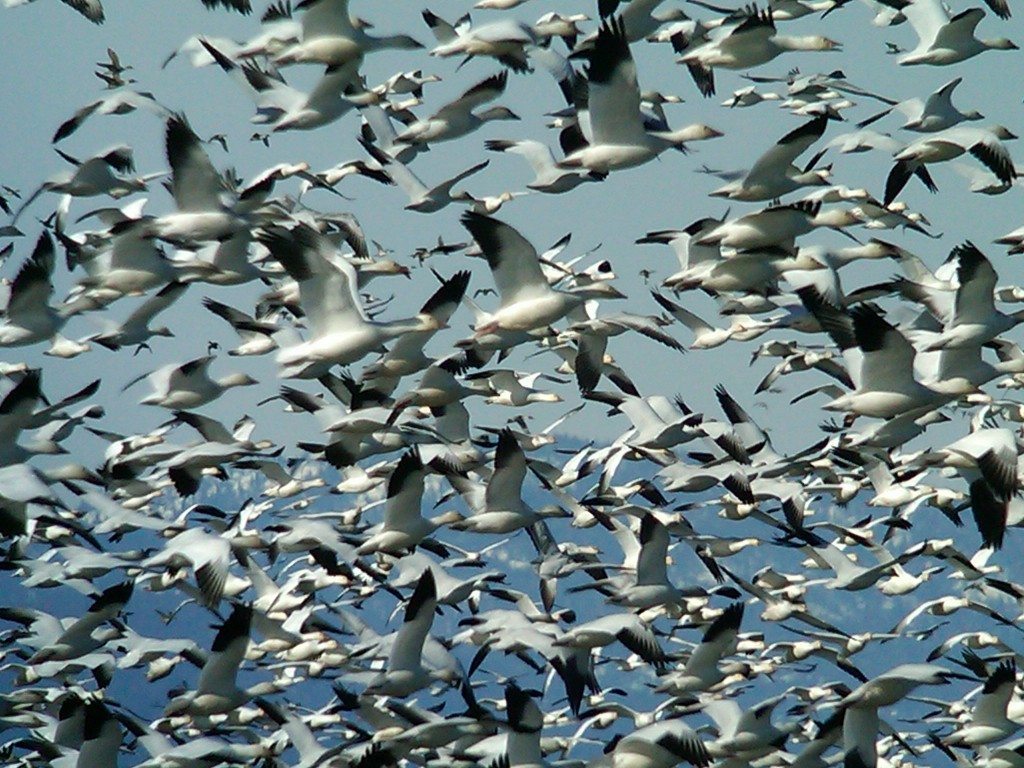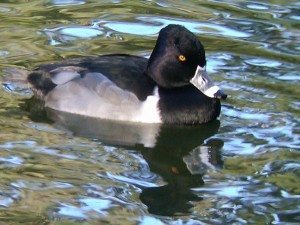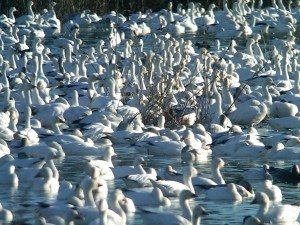Central Valley birding – go for the goose!
Editor’s note: We are nearing the end of peak winter birding season in the Central Valley. If you haven’t been there, now is the time! Golden Gate Bird Alliance board member David Anderson offers some tips and routes.
By David Anderson
The sky filled suddenly with a blizzard of snow geese, lifting in waves near and far — ten thousand or more. A thousand undulated in the distance, winging high; a few thousand rose then settled back close by; several thousand more circled restlessly.
For a while, the horizon filled with their movements, alternating bright flashes of white as they turned in the sun. Then, the various groups landed or headed away to work (foraging the nearby fields). A cacophony of noise – almost hurting our ears – filled the air with the geese. Ears ringing, eyes wide, I laughed in pure joy. The host of wildlife filling the bright, blue sky was a wonder to behold, a scene of nature’s glory.
Our viewing platform was in the midst of the Sacramento National Wildlife Refuge, part of a system stretching the length of the Central Valley from Redding to Bakersfield. Thirty refuges provide nearly 400,000 acres of wildlife habitat. California wildlife management areas add almost half a million acres more. The two systems give protection to tremendous numbers of migratory birds coming here for the winter, as well as numerous other wildlife species. These lands offer incredible viewing, especially the areas between Willows and Los Banos.

The U.S. Fish and Wildlife Service last year reported 48.6 million ducks in the U.S. and Canada, the most recorded in the 57 years of surveys! Clearly the breeding conditions were optimal. The estimate was that 5 million ducks would winter in the wetlands of the Central Valley, along with record numbers of geese. A mid-winter survey shows about 4 million ducks and one and a quarter million geese. That’s a lot of feathers out there.
We’re reaping the rewards with incredible viewing opportunities, enhanced by long stretches of clear, sunny weather. Snow Geese, Ross’s Geese, Canada Geese, and White-fronted Geese all appear in big numbers. Northern Pintails, American Wigeons, Northern Shovelers, and Green-winged Teal are in even larger numbers.
Colusa NWR
My favorite birding route from the Bay Area to the Central Valley is I-80 heading east past Vacaville, then I-505 across to I-5 near Dunnigan. Continue north on I-5 to the Williams/Highway 20 exit, and go about six miles east on Hwy 20 to the Colusa National Wildlife Refuge on the right.
The Falcated Duck, a visitor from east Asia, is still tantalizing viewers at Colusa, often easily seen from the platform of the first ponds. He wandered up to the Sacramento NWR in late December but was recently back at Colusa, seeming to favor that spot.

The three-mile auto tour at Colusa is a good warm-up for things to come, giving ample sightings of ducks, geese, raptors, wading birds, and songbirds. When you exit the Colusa NWR, stay on Hwy 20 east to Yuba City, taking Hwy 99 north to Live Oak, then left on Pennington Road following the signs to Gray Lodge Wildlife Area.
Gray Lodge Wildlife Area
Gray Lodge is a magnificent 9,100 acre habitat surrounded by agricultural areas. This is hunting season at both state and federal wildlife areas, with hunting generally limited to Wednesday, Saturday and Sunday. So it is best to plan around those days or otherwise to avoid hunting areas, which are well-marked.
Entering Gray Lodge, there is a registration office, which charges $4 for a wildlife viewing permit. Proceeding down the access road, raptors are readily visible — Red-tailed and Red-shouldered Hawks, American Kestrels, Cooper’s Hawks, White-tailed Kites, and Northern Harriers. The whole Central Valley is teeming with raptors.
After the first S curve, stop on the left at a small pond. (Park just off the road, there is no auto entry into this spot.) Right off the road and a little down the trail, several Phainopepla have taken up residence. They are fairly easy to see, having shown themselves during my last three visits. Also there, I’ve found Western Bluebirds, Northern Flickers, Yellow-rumped, Townsend’s and Orange-crowned Warblers, Ruby-crowned Kinglets, and Black Phoebes, among others. After passing the ranger station complex, the auto tour begins at parking area 14. Or you can start with a walk, a nice self-guided path beginning across the road. There are several paths along the tour route. The snow geese here are bountiful! Some ponds are so full it is not possible to see water.
Snow Geese galore
Snow geese love the Central Valley these days because of agriculture. They fly to the outlying fields to forage for waste grain, crop stumps, and grasses. It’s gratifying to drive through many parts of the Central Valley and see the expanse of farms where the owners have agreed to flood part of their fields and not plow under the crop remains, giving the geese, cranes and other species a vast dinner table. An incentive program run by the state and several conservation groups encourages this practice, and both birds and wildlife viewers benefit greatly.

Today many of the waterfowl forage at night to avoid hunters. But it used to be that the geese would leave the refuges in the morning to forage and fly back in the evening to overnight in the ponds. I would note where they were landing, head there, and stop to watch the landings. Some of the ponds are bordered by trees, so rather than gliding in to land, the formations would arrive at a certain point and begin to circle, forming a vortex, funneling down with wings out and feet trailing under, acting as air brakes. As the circle narrowed toward the water’s surface, the feet would extend and each goose would land perfectly. They came in huge, noisy waves, one behind the other, sounding like confederates charging in waves up Cemetery Hill. (Okay, that’s too romantic, but what do you expect from a southern boy!)
As I watched the birds circling in the funnel of geese, several – I figured impatient teens – turned on a wing and cartwheeled down, spinning like a small plane out of control. Ten feet from the water, they put out their wings, held out their feet, and landed smooth as glass, wagging their tails, and honking with glee. And I was laughing with them, amused at such antics. What a sight!
And don’t forget ducks
Gray Lodge is filled with ducks, as well — Northern Pintails, Mallards, American and Eurasion Wigeons, Northern Shovelers, Green-winged Teal, Gadwalls, Bufflehead, Ruddy Ducks, and Ring-necked Ducks. The eastern portion of Gray Lodge is closed to non-hunters during the season. After the season (latter January), the end of the east side with its small wooded lake is a good place to see Wood Ducks. Gray Lodge boasts almost 300 resident and migratory bird species and is a must for taking in the excitement of the Central Valley.

Birding at Willows
I usually head north on Pennington Road, west on Colusa Highway/Gridley Road, north on River Road winding my way north to Biggs-Willows Road/Rte 162, then west to go overnight in Willows. Passing through the fields outside of Gray Lodge, there often are great numbers of White-faced Ibis and other wading birds and shorebirds. The roads to Willows are flanked with raptors in trees, on telephone poles, and circling high and low. It’s also worth stopping to see the variety of songbirds there.

I discovered the Willows Cemetery (also called Catholic Cemetery) several trips ago. It’s a short ways east of the Willows city limits on East Wood Street/Rte 162. The Cemetery is a great spot to visit late in the afternoon and early morning, a wonderful bird magnet. I’ve recorded bluebirds, several species of warblers, kinglets, Black and Say’s Phoebes, Red-breasted Nuthatch, Lesser and American Goldfinch, Nuttall’s Woodpecker, Cedar Waxwings, Evening Grosbeaks, flickers, robins, Great-horned Owls, and many other species. It’s a great bird oasis amid an urban area.
Sacramento NWR
After a night in Willows, and a morning visit to the Cemetery, I head south on I-5 to the Sacramento NWR. Tens of thousands of waterfowl inhabit the 30,000 acres of the Refuge. At any time there may be huge numbers in the air putting on a visual and aural show. The many long vistas lend to the incredible sight of masses of birds rising into the air. Sometimes they are heading to feeding areas, other times taking off in response to an eagle soaring low. (A Harrier generally rates only an increase in honking level!)
Many other species are accessible to birdwatchers. A short way into the six-mile auto tour, a grassy meadow often has Ring-necked Pheasant. One morning, I counted 18 of them foraging their way across. Past the viewing platform I have several times found Redheads, a pair working in and out of the reeds. White Pelicans make a home here, as do Cinnamon Teal, Loggerhead Shrikes, several gull species, Long-billed Curlews, Black-necked Stilts, Bald Eagles, and Peregrine Falcons.
The Cosumnes/Woodbridge area
An alternative, slightly more southern route to the Central Valley from San Framcisco is I-80 east across thge Bay Bridge to I-580, then Hwy 24 to Walnut Creek, I-680 north to Rte 242 north and continuing on I-4 to Rte 160 north and Rte 12 east to I-5 (Better Google it or get a good map!).
Once you reach I-5, a short way north is the Turner Road exit. Going north on Thornton Road you find Woodbridge Road, which taken west goes under the freeway and through an agricultural area. Watch closely in the fields and there will be hundreds, maybe thousands, of Sandhill Cranes resting or socializing. Keep your windows down to hear their raucous calls.

If at all possible, park in the Woodbridge Ecological Reserve in the evening and wait for the flights of cranes to arrive from fields near and far, to stay the night in the reserve. I’ve watched three to five thousand cranes come into Woodbridge, flight after flight after flight, continuing right through the sunset. They’re as graceful as they are noisy, and it’s a wonderful experience.
Back on Thornton Road, go north to Peltier and get back onto I-5 north for about nine miles, exiting at Twin Cities Road, then east another mile to Franklin Blvd. Take Franklin right (south) a mile and a half to the Visitor Center. Cosumnes Reserve is a joint project of The Nature Conservancy, Ducks Unlimited, and California Department of Fish & Wildlife. The 46,000 acres encompass a terrific stretch of river habitat, oak woodlands, and a series of ponds that attract geese, ducks, shorebirds, wading birds and others (like American Pipit), all with interlinking trails and wonderful viewing.
I’ve watched a large group of Cedar Waxwings in the trees abutting the road, and seen Common Yellowthroat, Marsh Wrens, House Wrens and Bewick’s Wrens. I’ve heard both Virginia Wails and Soras, but have seen only the latter. In the lower pond, there are Black-bellied Plovers, American Avocets, Greater Yellowlegs, Least Sandpipers, Dunlin, Long-billed Dowitchers, and Wilson’s Snipes. Yellow-billed Magpies are in the surrounding fields and raptors again are abundant. Cosumnes is an easy place to spend half a day, and there’s little better way to lower one’s blood pressure!
From Cosumnes, it’s an easy stretch to go up to Gray Lodge or the other reserves, or to head south to San Luis NWR or Merced NWR, near Los Banos.
Echoes of ages past
Sacramento NWR and the other refuges and wildlife areas really are part of only a remnant system, small fragments of what once was a huge floodplain with marshes, lakes, grasslands, and scrub filled with wildlife. There once were an estimated four to five million acres just of wetlands!
When in the refuges, I’m relaxed and content, and I’m proud of the federal and state agencies that set aside so much habitat. It’s satisfying to see large private tracts of farmland that have been turned into foraging habitat for waterfowl. Yet, riding to the refuges, I pass mile after mile after mile of farm and ranch land that has been drained and leveed. Viewing those areas or sitting in the reserves watching a sky full of geese, I think of what used to be — a population ten times the number of waterfowl and other bird species.

Over five million ducks and geese are out there today, but it’s only a tenth of what at one time was tens of millions! What an incredible sight that must have been. Old journals talk of endless flights of birds, of darkened skies. In the evening, over a cocktail (or two), we speculated that we’d give a year of our lives — maybe a few –to go back 150 years and see that sight. There’s something to ponder!
The Central Valley is rich in wildlife over the winter and an exciting and rewarding place to go. I’ve been half a dozen times over the last couple months and would have doubled that if possible. The birds are particularly thick this year and the more time spent there, the more nature puts on displays or neat acts of “birdery!”
My advice: Go as soon as possible, as often as possible. Enjoy.
———————–
David Anderson, vice president of the Golden Gate Bird Alliance Board of Directors, was Director of the San Francisco Zoo for 14 years, leading its transformation into a modern zoological institution with a strong focus on conservation activities. More recently, David led Audubon of Florida, where he was responsible for the Corkscrew Swamp Sanctuary and six other sanctuaries.
